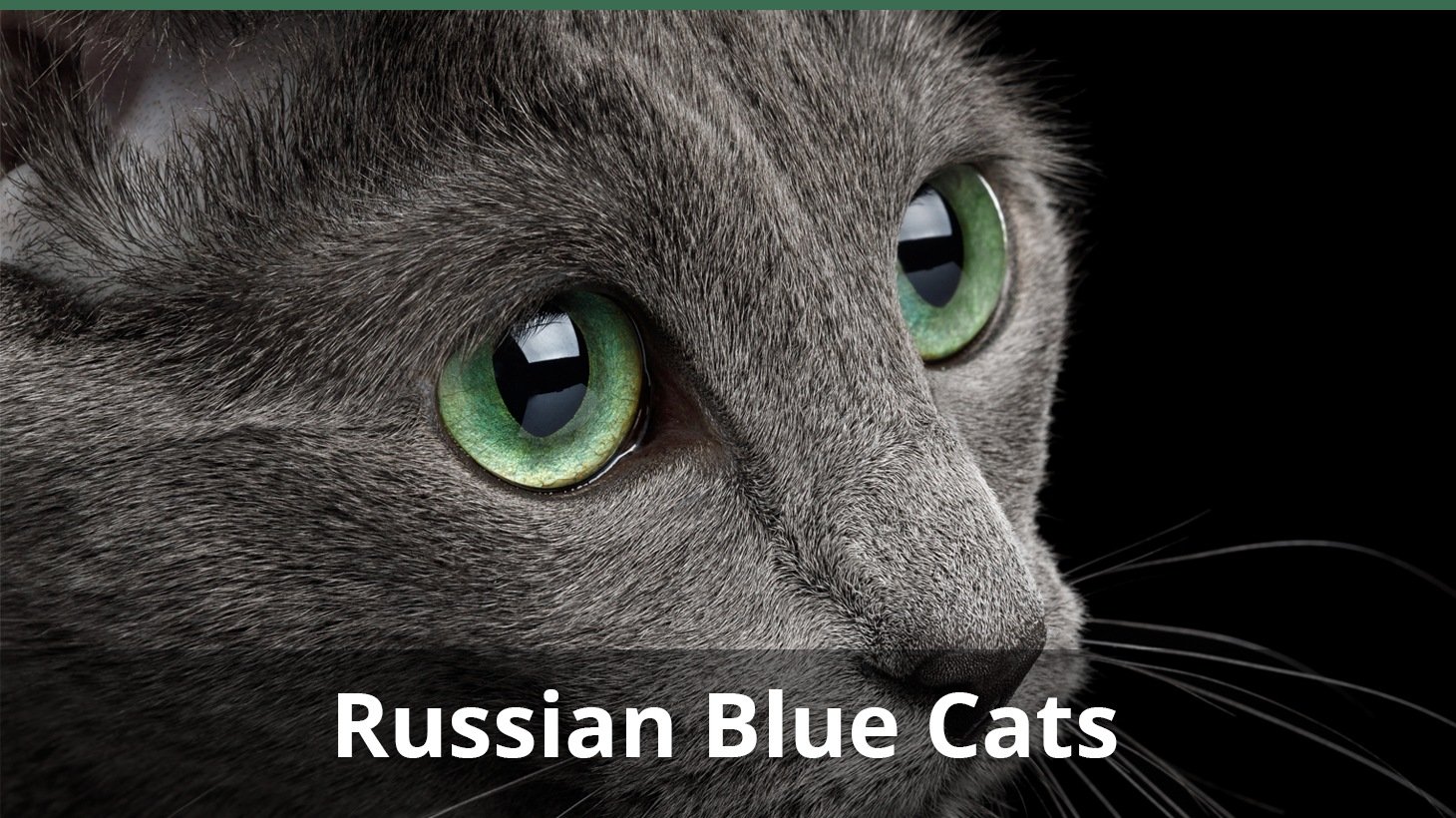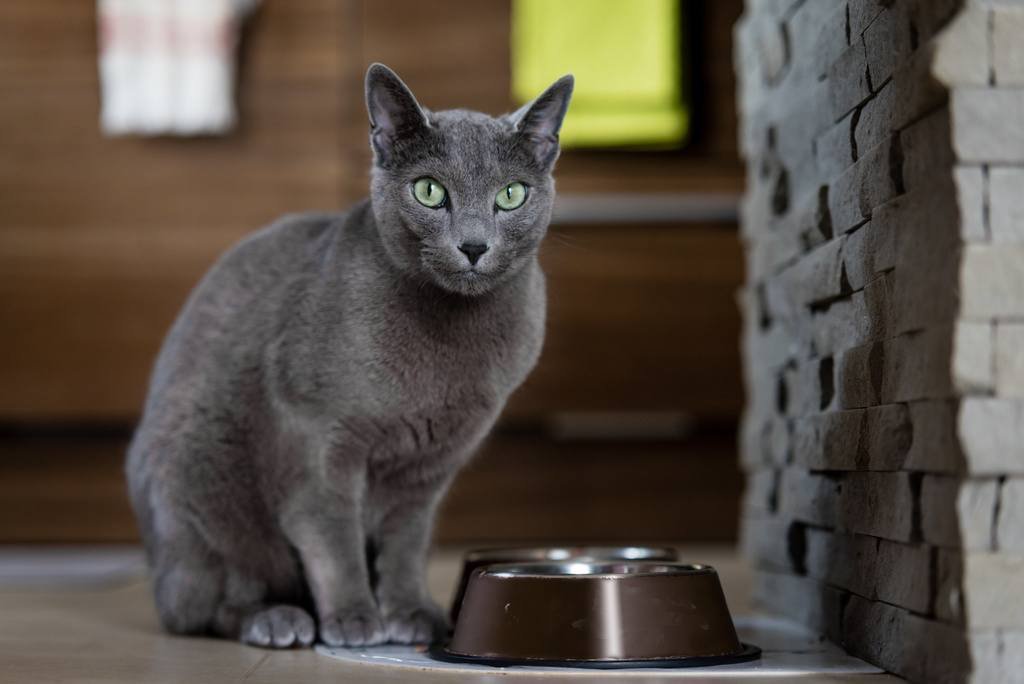The Russian Blue is a dignified and somewhat rare short-haired cat best known for its gorgeous shimmering blue coat and emerald green eyes. It has an elegant, slender shape and a beautiful face with an expression that’s often referred to as smiling. Many refer to it as a “Mona Lisa smile.”
But this glamorous stunner is no diva.
The Russian Blue makes a great pet that’s suitable for most households. Their personalities are engaging and lively. They are easy to care for and easy to get along with.
But that doesn’t mean they’re pushovers! You will want to keep the upper hand with these beauties, or they will end up training you.
Unique Facts About Russian Blue Cats and Kittens
A Naturally Occurring Breed
The Russian Blue is what scientists call a naturally occurring breed. This means that it’s a breed created through natural selection (think Darwin) rather than artificial selection (selective cross-breeding done by humans).
Russian Blue breeders take this seriously and work hard to keep them that way.
Russian Blue Origins – From Russia With Love
The Blue’s exact origin is lost to history, but it’s said to have been a favorite of the Russian Czars and Britain’s Queen Victoria. Historians believe they arrived in Europe on ships from Arkhangelsk, Russia. It was known for some time as the Archangel Cat.
We do know that in 1871, a Russian Blue competed in the first- or second-ever cat show (depending on whom you ask), which was held at the Crystal Palace in London.
To Near Extinction and Back Again
Just as the Russian Blue was beginning to gain in popularity in Europe, World War II nearly caused their extinction (along with many other breeds).
Breeders joined together to rebuild the breed by crossing the remaining Russian Blues with other blue breeds, most notably the British Shorthair and the Siamese.
Once the Russian Blue was firmly re-established, breeders began working to reverse this process and have nearly eliminated the Siamese points from the breed.
Their goal has been to return the Blue to its natural state, which they have accomplished (with the rare exception).
The Russian Blue first appeared in the United States in the early 1900s, where it’s steadily gained popularity, and with good reason. The Russian Blue is not just a pretty face; it’s a sweet-natured, loveable cat that fits in well with nearly any family.
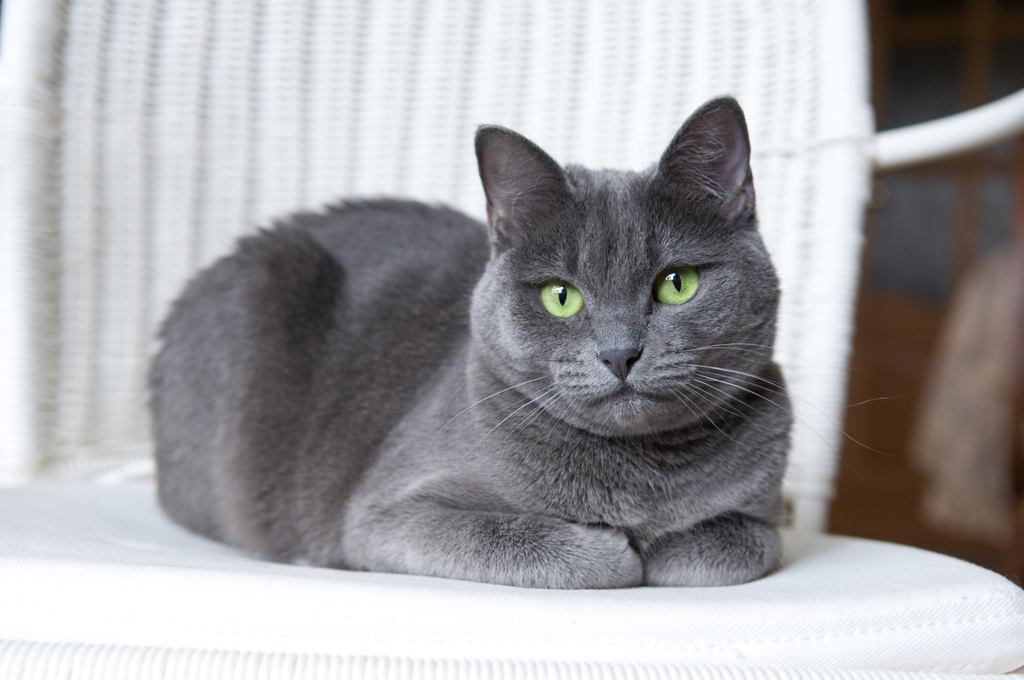
Independent but Interactive Personality
Russian Blues are content to entertain themselves if there’s no one home during the day. But they will let you know they’re glad to see you when you get home.
They’re likely to follow you around the house, and don’t be surprised if they strike up a conversation. They are quite talkative (but soft-spoken). Russian Blue owners say that they love to engage in back-and-forth conversations with their owners.
This makes them great company for a person who lives alone.
Highly Trainable
You may have thought that it’s impossible to train a cat (except to use the litter box), but that’s not true. Some cats are more trainable than others, though, and the Russian Blue is one of those.
Their intelligence and docile nature make them good candidates for training, and they enjoy learning trick behaviors.
Once a Kitten, Always a Kitten
The Russian Blue is an unusually playful breed. In their desire and energy for play, they remain kittens well into adulthood. They love to play with toys, so you’ll want to have plenty around.
They also are known for enjoying a game of fetch with their owners. (But more than one owner warns that if you’re not careful, they will train you to be the fetcher!)
With their high intelligence, they also need mental stimulation and enjoy interactive toys and puzzle toys.
Meticulous, Even by Cat Standards
The Russian Blue is fastidious about keeping itself clean. It will also insist on a clean litterbox. If it feels your housekeeping is lacking, it will let you know. It will find another spot to do its business.
Keep Me Inside, Please!
The Russian Blue‘s gorgeous coat may have been designed for the cold Russian climate, but don’t let that fool you. Most prefer to be indoor cats and get along just fine with the warmer indoor temperatures.
Not Hypoallergenic
Russian Blues do not shed much, and many people think that they’re hypoallergenic. This is not strictly true. But they do produce less glycoprotein Fel d 1 (a protein in saliva and skin that is a known allergen) than most cats.
This makes them more likely to be compatible with family members who have mild to moderate allergies.
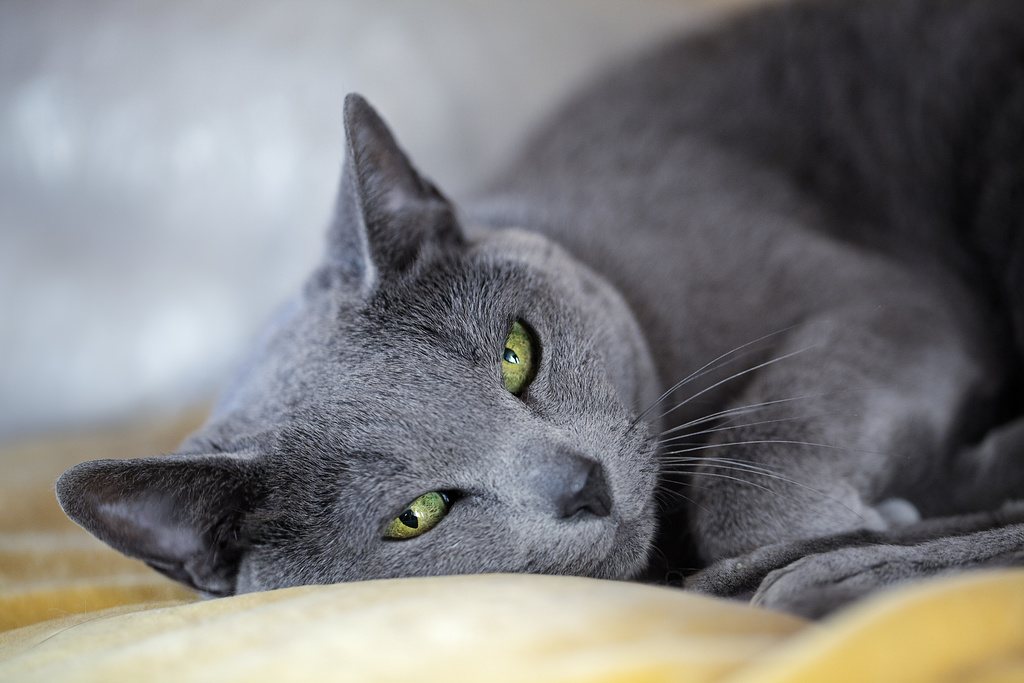
Russian Blue Traits
The Russian Blue is a highly intelligent cat with a gentle and docile nature. They’re devoted and affectionate to their human families.
Many Russian Blues enjoy cuddling and make good lap cats. They are excellent choices for the elderly. They form very strong bonds with their owners and make ideal companions.
This cat has a dignified air about it. If it feels you have slighted it in some way, it will let you know by ignoring you until it decides to forgive you.
But they are also unusually sensitive to human emotions. Your Blue will sense when you’re down and will snuggle in to cheer you up.
Of course, not all cats will behave in the same way, but in general, they enjoy children and can handle a small amount of rough play.
Their playfulness and gentle natures make them a good choice for families with kids. Younger children will need to be taught to be gentle with them, though.
They can also do well with dogs and other cats, especially if they are raised with them. Even when they aren’t, if you introduce a new pet to the family, they will be reserved while assessing the new situation. But eventually, they will accept the new family member.
The same is true for meeting strangers. They may appear shy at first, but they’re simply reserving judgment. It can take some time, but when they decide that someone is worth knowing, they will warm up and accept them.
Until then, they will simply leave the room or hide if they’re uncomfortable. You can almost count on that if you’re having a large gathering.
They are equally observant of everyday goings-on in the household. You’ll get reminders of their superior intelligence when they do something they have learned from watching you—like opening and closing cabinets and doors.
They will also notice—and remember—where you’ve hidden their favorite toys or treats. They’re known for having a great memory.
When they’re resting, Blues like to hang out in a sunny window, and like most cats, they love to climb. The Blue is one of the most athletic cat breeds. You will often find them perched at the highest point in the room.
Potential Drawbacks to This Breed
When considering a Russian Blue, the most serious concern is that they aren’t the most adaptable of cats. They don’t usually take well to changes in their environment. If you are a family that moves a lot, this may not be the breed for you.
Russian Blues also need structure and routine. They don’t like their schedules being disrupted.
They also form strong attachments to their owners, which can lead to separation anxiety.
They also need consistent physical and mental stimulation, or they may get bored and develop unwanted behaviors.
Appearance of the Russian Blue
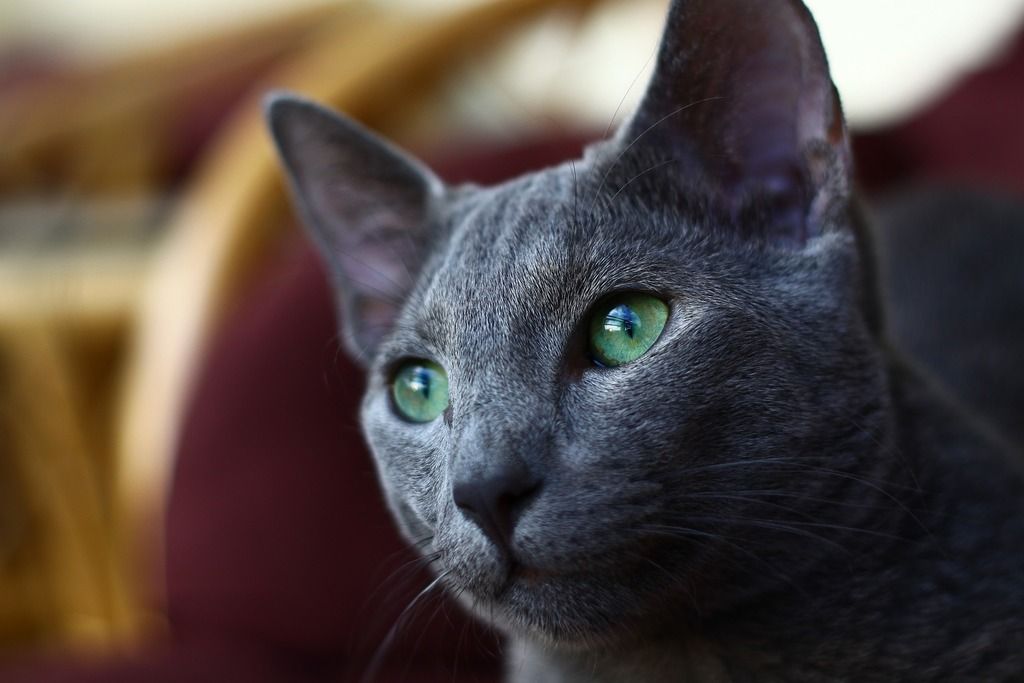
General Appearance
The Russian Blue is a beautiful cat with a unique appearance and elegant features. There are two variants of Blues: American Russian Blues, which have a lean, slender shape with long legs and a long body; and European Russian Blues, which will be stockier and a little larger. Otherwise, they are identical.
The Cat Fanciers’ Association requires, for designation, that Russian Blues have a smooth, wedge-shaped head with a blunt muzzle.
Size
The Russian Blue is a medium-sized cat. The average size of male Blues is 10-12 pounds. Females average 7-10 pounds.
Coat
Their most striking feature is their gorgeous coat. It’s a double coat that is short, plush, and velvety soft. The individual hairs on the outer coat are lilac at the base and tipped with silver, giving the Russian Blue a lustrous, shimmering appearance.
Russian Blues are nearly always blue. Occasionally one will be born with a white “locket” on the throat, but that is considered a fault in show cats.
Some Russian Blue kittens are born with “ghost stripes” that resemble the markings of a tabby. They usually disappear as the cats mature.
Neck
The neck is long and slender. Its head has a wedge shape with seven flat planes arranged so the mouth turns out a bit at the upper corners, giving the appearance that the cat is always smiling.
Ears
The ears are set wide apart, with height and width approximately the same, tapering to pointed tips.
Eyes
The eyes are round and bright emerald green in adult cats. They have a stunning effect that’s set off by the blue of their fur. Kittens will have yellow eyes that darken to green as they grow.
Look-Alikes
Russian Blues resemble Chartreux cats as well as Korats as well as Nebulungs.
Russian Blue vs Chartreux
The Chartreux cat very much resembles the Russian Blue. However, the easiest way to tell the difference is by looking at the eyes.
Russian Blue cats have green eyes, although kittens’ eyes may take a while to change from yellow to green. Chartreux cats typically have bright orange eyes.
The resemblance between Russian Blue and a Korat is eerily similar. The best way to determine is by closely looking at the eye color and the face shape.
In contrast to Russian Blue‘s green eyes, Korats are slightly more yellow-ish tinged.
A Korat’s face shape is heart-shaped, while a Russian Blue is more wedge-shaped.
Russian Blue vs Nebulungs
Throughout its history, the Russian Blue has been used as an outcross for several other breeds. This means that they were selectively cross-bred in the development of another breed, just as the Blue was once cross-bred with the Siamese.
One of these breeds is the Nebelung, which was cross-bred with two black domestic cats, one of which had long hair. Many people call the resulting Nebelung a long-haired Russian Blue.
Other than its longer hair, the Nebelung does look like a Blue. It also has similar behavior and temperament. But is it a true Blue?
The answer is no. The Nebelung is a separate breed. Most of the major breed clubs maintain that there is only one Russian Blue, and it is short-haired.
Health Concerns
Because breeders have worked so hard to keep the Russian Blue a natural breed, they haven’t inherited any genetic health conditions.
There is a slight increase in the risk of urinary tract issues and bladder stones in Russian Blues.
The biggest concern, however, is that they are prone to obesity, as discussed above. They have large appetites, so you need to watch their weight carefully.
If your cat gains too much weight, they will be susceptible to the health issues common with obesity. These can include hypertension, diabetes, heart problems, arthritis, respiratory issues, kidney stones, and kidney failure.
If your Blue ever needs surgery, obesity will increase the risks of the procedure.
Russian Blue Life Expectancy
This breed has a very long life compared to most pets. Its average lifespan is 10-15 years, but some have been known to live to age 25.
Grooming Your Russian Blue
Despite its glamorous appearance, grooming the Russian Blue is easy and straightforward. They need a combing once or twice a week (which they will probably love!), regular ear checks, and routine care otherwise.
All you’ll need for grooming supplies are a medium-toothed comb, a toothbrush, and nail clippers.
Diet
Because of its predisposition to obesity, you will want to monitor your Blue’s diet carefully. Again, free-feeding is not a good idea for this breed.
You will need to be strict about portions and switch them to a low-calorie food if necessary. You will also want to keep treats to a minimum.
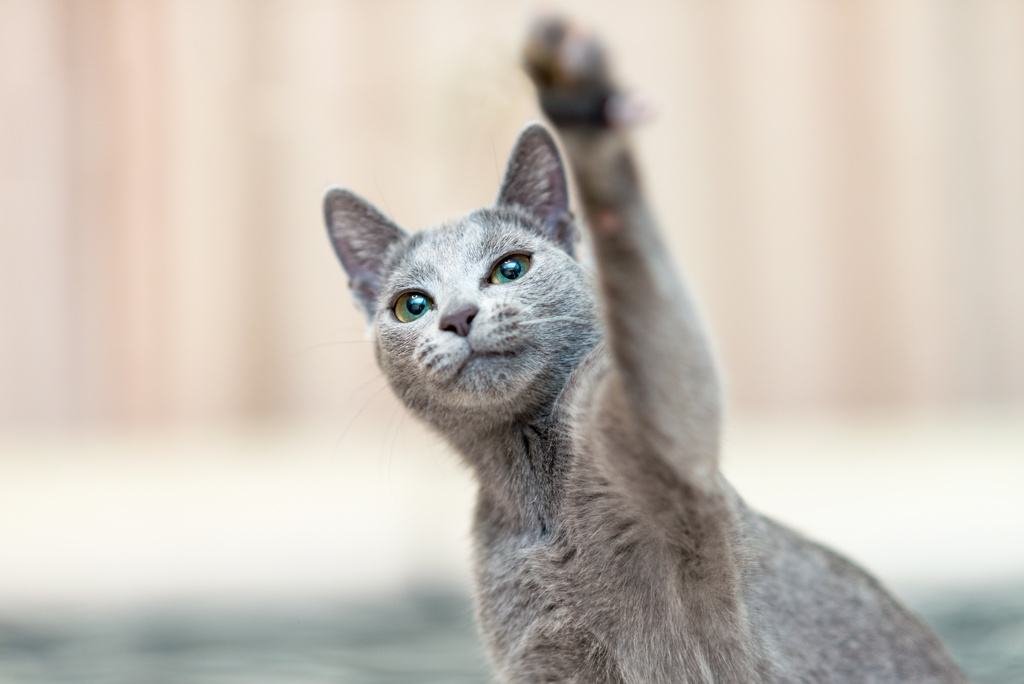
Facts About Russian Blue Kittens
A Russian Blue litter will usually have from one to six kittens after a 60- to 69-day gestation (average 63-64 days, or 9 weeks). The average litter size is three. Kittens aren’t usually separated from their mothers until they are 13 weeks old. Most are sold as pets, already spayed or neutered.
If you’re planning to breed your Russian Blue, you need to be sure the kitten you want will not be sterilized. Expect to pay more for a Russian Blue kitten that is approved for breeding by the seller’s breed club, as it will require a pedigree and clearance for genetic conditions.
Where to Adopt, Rescue, or Buy a Russian Blue Cat
Buying a Russian Blue from a Breeder
How Do I Find a Reputable Russian Blue Breeder Near Me?
The Russian Blue is a fairly rare cat, so you may need to travel a bit to find one. But the closer to your home, the better in case you run into a problem after you bring your kitten home.
Possible resources for finding a Russian Blue breeder include:
- Area veterinarians.
- Local or regional cat shows. Even if there are no breeders with purebred Russian Blue kittens for sale, other breeders may be able to make recommendations. Quality breeders travel in the same circles, and most know each other.
- Breedlist. This site lists breeders of most cat breeds.
- The Cat Fancier’s Association (CFA).
- Russian Blue Fanciers (RBF).
- The International Cat Association (TICA).
Choosing Your Breeder
With any luck, you now have a shortlist of potential breeders. The first step is to schedule a site visit if at all possible.
Observe whether the facility is clean and the cats look healthy and that their basic needs are being met (adequate space, food, clean water, etc.)
You should also ask to see the mother (or both parents if the father is on-site). If you’re buying a pedigreed kitten, you will want to see the pedigrees for several generations back to be sure you’re getting what you’re likely paying a premium price for.
TICA recommends having a list of questions prepared to ask the breeder. The most important question is, do they provide a health guarantee? You will also want to know what conditions the guarantee covers.
Has the kitten had all of its vacations? Ask for a copy of the vaccination record.
How have they been socialized? This cat tends toward shyness, and a cat that hasn’t been exposed to humans early in its life may be fearful and anxious. It may never form the strong bonds the breed is known for.
Can they provide you with references from others who have purchased kittens from them? If they do, check them. If they don’t, consider that a red flag.
A reputable breeder will also have questions for you. Ethical breeders want to find the best possible placements for their cats. They will want to be sure both the breed and the individual kitten you’re considering are a good fit for your lifestyle.
For more suggestions on how to find a reputable breeder, visit the CFA.
How Much is a Russian Blue Kitten?
Expect to pay anywhere between $400 and $750 for a Russian Blue from a breeder. This breed is in high demand, so they command high prices. If you’re looking for a cat for show or want an especially valuable pedigree, the Russian Blue kitten price will be much higher.
I Would Like to Adopt. How Can I Find Russian Blue Rescues?
If you would prefer a Russian Blue adoption, there are good resources available for you, too.
Because this is a relatively rare breed, local shelters may be a longshot. Even so, it wouldn’t hurt to let shelters in your area know that you’re looking for one.
You can also search the following web sites to find Russian Blue rescues:
- Petfinder.
- Rescue Me! Russian Blue Rescue. This group also has a Facebook page.
Facebook groups are another great resource for connecting with rescue organizations. A simple search should turn up some options.
Naming Your Russian Blue Kitten
Choosing a name for your new baby should be fun, but it can feel overwhelming. Have you considered giving it a Russian name?
If so, check out Find Cat Names. They suggest Russian names for males and females and even words for Russian terms of endearment. There are some great possibilities here.
For other naming suggestions, the site Russian Blue Love also has great suggestions.
Checklists for Bringing Your Russian Blue Home
It’s time to bring your new baby home! Whether you’ve opted for a new kitten or a Russian Blue cat adoption, you will need to be patient with the transition process.
As we touched on earlier, Russian Blues often find transitioning to a new environment stressful. You will want to follow your breeder’s instructions carefully.
The following checklist will help you and your new cat get off to a great start.
- Familiar food. It’s not a good idea to change food when you first bring your kitten home. It’s better to make a gradual transition to the brand you plan to use.
- Food and water bowls.
- A warm bed or basket with a washable blanket or “vet bed.”
- A litter tray with the litter the kitten is used to using. You can always change it later.
- Grooming essentials: A comb and/or brush, nail clippers, and a toothbrush should be all you need.
- A gate, if needed, to contain your kitten in a small area. It’s best to let it explore its new home gradually as it develops confidence.
- Lots of toys!
Visit the Russian Blue Breeders Association for more great tips on making your new kitten’s transition a smooth one.
Is the Russian Blue the Right Breed for You?
By now you should have a good sense of whether the Russian Blue is a good fit for your lifestyle. The bottom line is that this breed makes a wonderful pet for almost any household.
If you have the time and are willing to give this cat the attention it craves, the Russian Blue will enrich your life in countless ways.
It may even put a Mona Lisa smile on your face!

